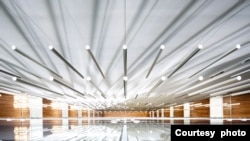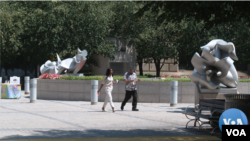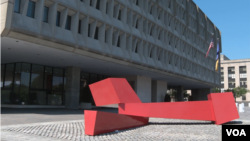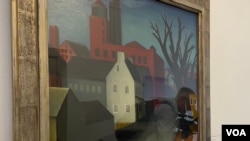This website uses cookies so that we can provide you with the best user experience possible. Cookie information is stored in your browser and performs functions such as recognising you when you return to our website and helping our team to understand which sections of the website you find most interesting and useful.
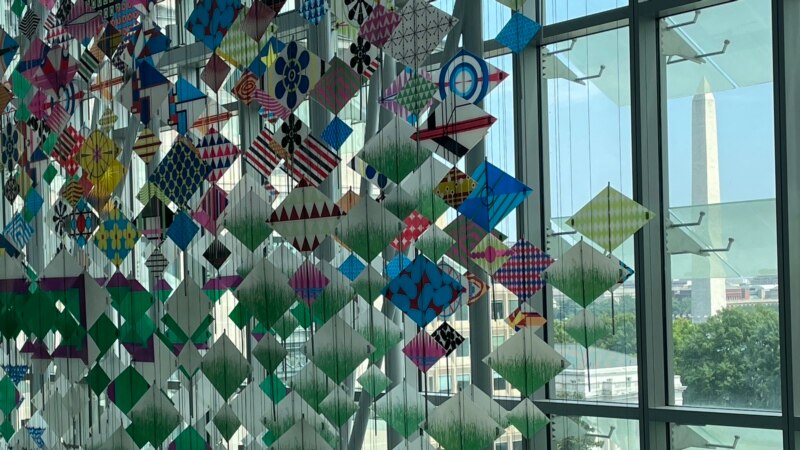
All About America explores American culture, politics, trends, history, ideals and places of interest.
WASHINGTON/NEW YORK — Almost since its founding, the United States has incorporated artwork into federal spaces. The U.S. Capitol, with its domed ceiling, murals and ornamented doors is a prime example. The iconic Washington Monument, begun in 1848 and finally completed in 1888, was commissioned by the U.S. government.
Today, about one-half of 1% of the budget for a new federal building goes toward commissioning artists to create original pieces for that particular structure.
“It allows creative voices to be part of the whole American dialogue,” says Jennifer Gibson, director of the Center for Fine Arts at the U.S. General Services Administration (GSA), the government agency that oversees federal buildings. “It's a record of our past, and it creates a dynamic presence in towns and cities and border stations across the country.”
Artists join a GSA registry to be considered for a project. The commissions are decided by a panel that includes tenant representatives, the lead architect, community members and arts professionals, as well as the GSA. The artists are given details about the building project and asked to come up with an artwork they think is best suited for the space.
“I think, in a way, it shows the plurality of who we are. And the artists represent so many different communities, so many different backgrounds,” Gibson says. “And I think that's one of the glories of it. That as a nation, we are open to all of these different ways of understanding ourselves.”
New York artist James Carpenter created two artworks for federal buildings. The first, installed in 2000, is a glass-and-aluminum lens ceiling for a courtroom at the Sandra Day O’Connor U.S. Courthouse in Phoenix, Arizona. The second is a sculpture of suspended light pillars, using aluminum and stainless steel, which was installed at the Orrin G. Hatch U.S. Courthouse in Salt Lake City, Utah, in 2014.
“My work is really about how to enhance or influence, in a very positive way, people's experience of spaces, primarily through the introduction of light and manipulating light and presenting light in a way that's perhaps highly unusual,” Carpenter says.
"It's about bringing the building alive or trying to make the building really be responsive to its context.”
The process, from selection to installation, can take several years. Carpenter says the Salt Lake City project took a total of 12 years. In addition to potentially being time-consuming, working with the GSA isn’t always as profitable as selling to the private sector, especially for artists in the prime of their careers. Gibson has seen artist commissions that range from $50,000 to $1 million. But the decision to work on government art projects doesn’t always come down to money.
“They're looking at it as a way to participate in what's going on in the nation and to be part of its history,” Gibson says. “This is for the nation. This is permanent. We will take care of it. And it's your way to participate.”
For Carpenter, who has worked on numerous projects for both public and private sector clients, other factors impacted his decision to work with the GSA.
“It's not like doing a commercial building, where every moment and every dollar is so critical and getting in the way. I think, with the GSA, everybody has really the same goal of building the highest-quality buildings possible,” he says.
"The buildings can be here 100 years, 150 years. It's all about longevity, durability. … The GSA is really trying to do something of exceptional quality, and something that really speaks to people using the buildings as an exceptional moment in their daily life.”
Today, the GSA follows guiding principles for federal architecture set back in the 1960s during the John F. Kennedy administration. A presidential committee stated that, "Where appropriate, fine art should be incorporated into the designs of federal buildings with emphasis on the work of living American artists."
These specially commissioned pieces, which can be found in 428 public buildings across the country, make up only a fraction of the GSA’s fine art collection, which contains 26,712 art pieces, including some pieces that date back to the 1850s.
The majority of artworks in the collection are paintings created during the New Deal era in the 1930s and early 1940s, when the government employed salaried artists. More than 23,000 pieces are on loan to 225 institutions, including museums, universities, libraries and public schools across the country.
Gibson and her colleagues are charged with keeping track of the far-flung collection.
In the 1990s, the Office of the Inspector General — which fights waste, fraud and abuse in the federal government — told the GSA to keep a record of the artworks, which are government property. Getting an official count, including identifying, locating and recovering New-Deal-era artworks, is an ongoing process.
“They were just hanging on the walls and offices. … Sometimes, people didn't like it. Or they redecorated, and they threw it in the trash. And years later, some of these things start to appear online and [on] websites at various auction houses,” Gibson says. “People saw them as decoration. They didn't see them as part of this whole legacy of federal art, and somebody would retire and they'd say, ‘Oh, she loved that artwork. Let's give it to her for as her retirement present.’”
The GSA collection is a treasure trove that belongs to the American people. The government doesn’t sell artwork in its possession, so it has no market value. However, as a record of the history of American culture, the collection could be considered priceless.



 Africana55 Radio
Africana55 Radio 